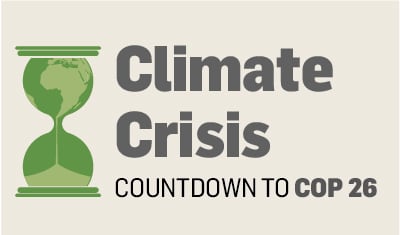Hopefully the forthcoming conference in Glasgow will nudge the world into taking effective measures to tackle climate change. Having missed our targets before, Ireland's challenge is to turn our aspirations into concrete actions. The carbon budgets published this week set out a framework for the next Climate Action Plan. Follow-through from targets to delivery will be essential.

Covid disruption only produced a small reduction in our greenhouse gas footprint. Thankfully such emissions are no longer closely related to the level of economic activity: otherwise halving our carbon emissions by 2030, as the law now requires, could involve a comparable drop in national income, with catastrophic results for society.
The alternative route, through developing and rolling out climate-friendly technologies, will allow us achieve our objectives at much lower cost.
Implementing these technologies will require substantial investment across the economy. However, investment takes time to ramp up, especially in the building sector. This emphasises the urgency of immediate action.
The scale of the necessary additional climate-related spending could amount to 2-4 per cent of national income between 2026 and 2030. Most of this will come in the form of investment (not current expenditure), which it is expected will peak in the latter half of the decade.
Compensation for sectors that are badly hit, especially agriculture, will add to the bill. Once the transition to a carbon-free economy is completed, additional investment requirements will tail off.
Fuel costs
Some investment is expected to substantially pay for itself, like the huge investment needed to achieve a target for generating 70 per cent of electricity from renewables. Our progress to date in this area has largely been paid for through savings on fuel costs, and it is to be hoped that will continue to be the case.
It is not expected that the Government will need to directly fund climate-friendly generation capacity, although revenues from the public service obligation are likely to play a role.
Further research is required to ensure that the investment programme and the structure of the electricity market is appropriate, delivering reliable electricity at minimum cost.
However, significant State support will be needed for decarbonisation in sectors where the necessary investment will not be offset by sufficient savings in fuel costs. Subsidies are likely to be needed to drive the necessary action in areas like retrofitting our housing stock, accelerated write-off of fossil-fuel cars, and in some sectors of industry.
A significant Government bill will be incurred to upgrade our housing stock to be more energy-efficient. While making fossil fuels dearer through higher carbon taxes is essential to incentivise households to make the change, that wouldn’t be enough to achieve what we need to do.
Even if those taxes doubled or trebled by 2030, from €100 a tonne to €200 or €300, it would still not be economic for many households to make the switch without significant subsidies.
Retrofitting houses
If we relied on such high carbon taxes as the main mechanism, many households would be paying exceptional bills over a long period, even if they were willing to change, because retrofitting our entire housing stock may take up to 30 years to complete.
Targeting compensation to vulnerable families who had sky-high energy bills, through recycling the revenues from exceptional carbon taxation, would be much more complex, having to differentiate between low-income families based on their type of heating.
The priority groups for subsidised retrofits should be households burning solid fuel or kerosene, low-income households and older households.
Targeting those groups (some of whom overlap) will result in the biggest reduction in emissions, the maximum impact on reducing poverty and the best health benefits. Such households are likely to be predominantly rural, especially those relying on solid fuel.
In some districts in major urban areas, the option of installing district heating systems using waste energy from data centres, other industrial processes, or incineration, may provide a better payback than retrofits.
While a key role in tackling climate change will fall to individuals and companies, the Government will have to carry a lot of the financial burden. Overall, the total cost of the necessary additional support from the Government to drive decarbonisation could peak over the coming decade at 2 per cent of national income.
On top of the cost of dealing with climate change, we will also need more public spending to fund an ageing population, meet housing needs and implement Sláintecare. That means the tax share needs to rise over the coming decade, albeit not as high as it reached in 2012 to tackle the financial crisis.






